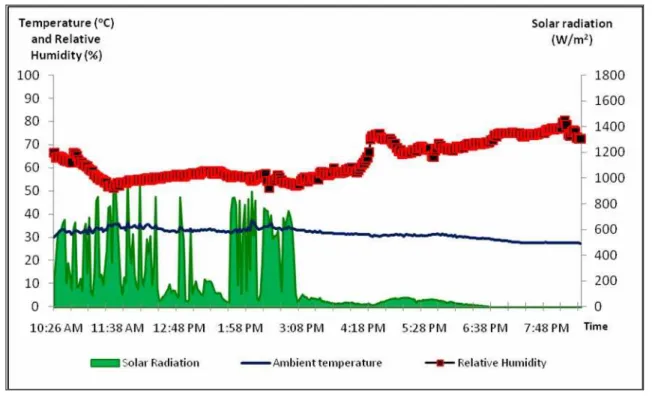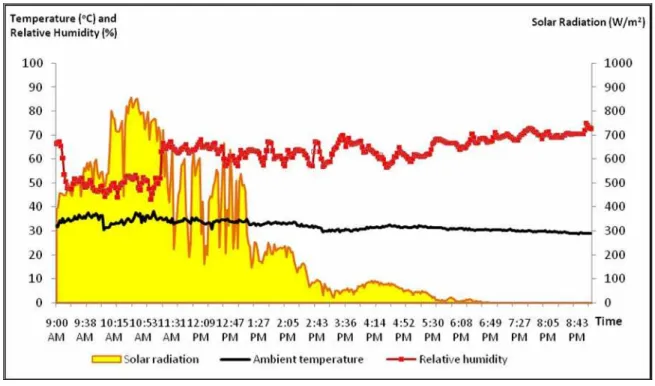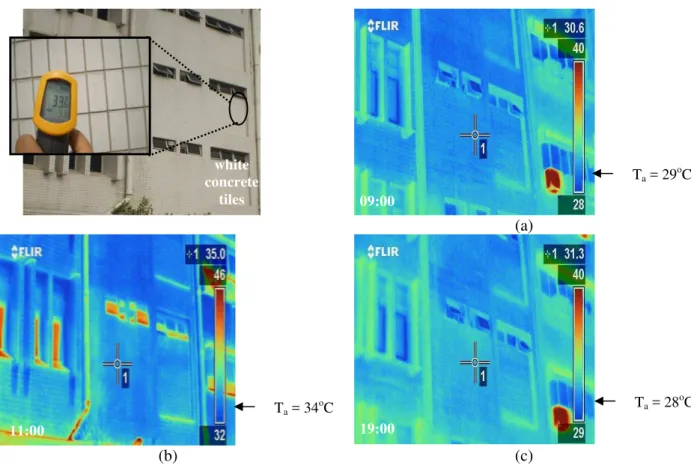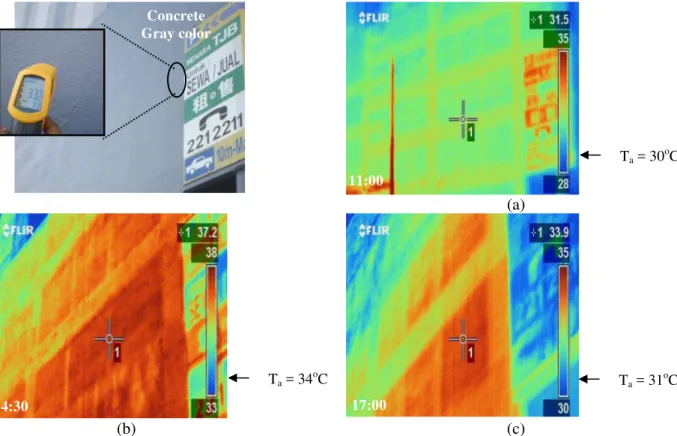E
NERGY AND
E
NVIRONMENT
Volume 3, Issue 4, 2012 pp.531-540
Journal homepage: www.IJEE.IEEFoundation.org
Investigation of thermal effect on exterior wall surface of
building material at urban city area
Mohd Fadhil Md Din
1, Hazlini Dzinun
1, M. Ponraj
1, Shreeshivadasan Chelliapan
1,
Zainura Zainun Noor
1, Dilshah Remaz
2, Kenzo Iwao
31 Institute of Environmental Water Resources and Management (IPASA), Faculty of Civil Engineering,
Universiti Teknologi Malaysia, 81310 UTM Skudai, Johor, Malaysia.
2 Faculty of Built Environment, Universiti Teknologi Malaysia, 81310 UTM Skudai, Johor, Malaysia. 3
Nagoya Institute of Technology, Nagoya, Japan.
Abstract
This paper describes the investigation of heat impact on the vertical surfaces of buildings based on their thermal behavior. The study was performed based on four building materials that is commonly used in Malaysia; brick, concrete, granite and white concrete tiles. The thermal performances on the building materials were investigated using a surface temperature sensor, data logging system and infrared thermography. Results showed that the brick had the capability to absorb and store heat greater than other materials during the investigation period. The normalized heat (total heat/solar radiation) of the brick was 0.093 and produces high heat (51% compared to granite), confirming a substantial amount of heat being released into the atmosphere through radiation and convection. The most sensitive material that absorbs and stores heat was in the following order: brick > concrete > granite > white concrete tiles. It was concluded that the type of exterior wall material used in buildings had significant impact to the environment.
Copyright © 2012 International Energy and Environment Foundation - All rights reserved.
Keywords: Building materials; Exterior wall surfaces; Surface temperature; Thermograph; Urban heat island.
1. Introduction
In general, high concentration of hard surfaces contributes to environmental issues. The primary cause of heat island in cities is because of the absorption of solar radiation by mass building structures, roads, and other hard surfaces during daytime. The absorbed heat is subsequently re-radiated to the surroundings and increases the ambient temperatures at night [1]. The use of appropriate materials to reduce the heat and to improve the thermal characteristics of the urban environment has gained increasing interest during recent years. Many research works have been carried out to evaluate the possible energy and environmental benefits, when light colored surfaces are used [2]. Furthermore, the impact of the optical materials and thermal characteristics on the urban temperatures as well as the possible energy conservation from heat stroke during the midday, were also investigated [3, 4].
areas. Some of the most important factors which may influence the UHI include canyon geometry, thermal properties of materials, anthropogenic heat, the urban greenhouse effect and evaporation surfaces [5]. The maximum UHI intensity usually occurs 3 to 4 h after sunset in the urban area [6]. Some of the radiation reflected from these surfaces leaves the urban environment much of it is intercepted and partially absorbed by other urban surfaces. As a result, cities tend to have lower effective albedo than its surroundings.
The aim of this study was to investigate the effect of construction materials that contributes to UHI and the thermal behavior of different materials used in surfaces of buildings. Infrared thermograph was used to detect thermal performance of selected buildings. The surface temperature in various type of building materials such as brick, granite, white concrete tiles and concrete (Figure 1) and their thermal properties (Table 1) were analyzed during peak sunshine and over brighthess conditions. The type of building material, vertical height and the impact of materials used towards outdoor environment were analyzed. This study can increase the awareness of urban planners, designers and decision makers on the importance of the construction material selection, which is not only for their esthetical aspect but also on the local climate and energy consumption of buildings.
(d) (c)
(b) (a)
Figure 1. The selected facade buildings in Johor Bahru, Malaysia; (a) Hospital Sultanah Aminah, (b) Menara Tabung Haji, (c) Foh Chong Building and (d) TJB Building
Table 1. Properties of external surface building materials
Location Type of material
in vertical surfaces
Density (kg m–3)
Specific heat (J kg–1 K–1)
Thermal conductivity (W m–1 K–1)
Emissivity* (at k = 8–14 µm)
(a) Hospital Sultanah Aminah
Brick 1700 800 0.84 0.93
(b) Tabung Haji Granite 2662 816 2.81 0.94
(c) Foh Chong Building
White concrete tiles
1900 800 0.84 0.97
(d) TJB Building Concrete (Grey color)
2300 1800 1.63 0.94
Note: * range of long wave length spectrum of ThermaCAM
2. Methods and procedure
2.1 Data logger and solar intensity measurement
Surface temperature was detected using Thermistor (±0.5 ºC) which was connected to a data logger of non-volatile memory (GRAPHTEC). In addition, temperature and relative humidity data loggers with accuracy of ±0.2 ºC were also used. Solar radiation was measured using a pyranometer (EKO, MS 602).
2.2 Thermal graphic measurement
specifications: 640 x 480 pixels, full colour and wavelength band of 7.5 - 13 µm with ±0.2 º C accuracy. It operates in two modes of wave lengths; shorter (3-5µm) and longer (8-14µm), where the later provides best results at low temperature (0-100oC). The infrared camera that was used in this study is suitable to investigate thermal effects on buildings and works in the long wave length spectrum. The camera is suitable for detecting minor temperature differences and less affected by the reflection caused by solar rays.
2.3 Data sampling
The study consists of in situ measurements of temperatures on selected buildings within 3km radius around Johor Bahru, Malaysia. In the beginning, various influences of weather and climates were investigated for 3 months. There are some limitations in this study such as wind that could reduce the effectiveness of the outdoor survey due to surface temperature shear effects. Similarly, rain may also lead to surface cooling, thus masking thermal effects from below the surface.
Information of thermal behavior of materials used in this study was examined through reflectivity, absorption and the albedo aspects. The surface temperature was taken with an Infrared (IR) thermometer and camera thermal images at every 30 minutes for 12 hours (9:30 am to l 9:00 pm).On each measured external walls, the temperature was measured at different heights, together with different parts of the exterior surfaces with an intention of correlation to the pedestrians’ thermal comfort perception (to ensure recorded surface temperature is representative). The ambient temperature, relative humidity and air velocity were then determined using Lutron 4 in 1 Environment Tester (Anemometer, Hygrometer, Light Meter & Thermometer).
3. Result and discussions
3.1 Analysis of existing exterior building based on different materials
This part discusses the four locations of the monitored area with different types of exterior wall building materials: brick, granite, concrete and white concrete tiles. The impact of this materials and the solar radiation intensity were then analyzed to find out their influences on the outdoor building surface temperature.
Case 1-Hospital Sultanah Aminah
The values used for the study were measured during typical clear weather. Figure 2 shows the ambient temperature, relative humidity and solar radiation between 10:30am to 9:00pm. The mean wind speed was 0.63m2.s, indicating moderate calm wind. The maximum ambient temperature was recorded up to 37.2°C at 2:12pm and the minimum was depicted at 27.4°C at 9:00pm, whereas the mean ambient temperature was recorded at 31.6°C. The maximum, minimum and mean relative humidity was measured at 80.4%, 51.2% and 62.9% respectively (Figure 2).
The survey was performed during the daytime (direct solar radiation) which produces thermal images at different temperatures (Figure 3). At the same time, a sensitive contact thermometer (shot-gun temperature and thermo couple) was monitored twice to ensure the accuracy of the online data logger. A correlation between infrared camera and contact thermometer was determined, and based on the images captured, a clear zone had been identified (Figure 3), which corresponded to the color characterization (lighter color represents lower temperature). The temperature detection of each image was prepared according to the local time and weather. The surface temperature of brick wall was 32.5oC at 9:30am and this was 7oC higher than the ambient temperature. At 12:00 noon, the building surface temperature increased to 41.1oC, as a result of solar heat absorption (from previous daytime). During this period the solar radiation was 1005.73W.m2, indicating the brick wall absorbed more heat from the direct solar radiation.
Figure 2. Ambient solar radiation, temperature and relative humidity for case 1
(a) (b) (c)
Figure 3. The visible and thermal image of brick wall at various period (a) morning, (b) afternoon, (c) evening
Case 2-Menara Tabung Haji
Menara Tabung Haji is a single detached-building located in Johor Bahru, Malaysia and based on the observations, the east-side exterior wall of the building reached higher solar radiation. Figure 4 shows the ambient temperature, relative humidity and solar radiation at a continuous period (10:52am to 10:00pm). It can be seen that that the highest solar radiation was noted at 1585.96 W.m² (Figure 4). However, since the orientation of exterior wall was not exposed consistently, the direct solar rays merely fell upon the samples until 6:00pm. The mean wind speed obtained was 1.8 m2.s, which indicated calm conditions. The maximum ambient temperature was depicted at 41.7°C (5:39pm), whereas the minimum was reported at 29.0°C (9:00pm). The maximum and minimum relative humidity was reported as 80.4% and 64.3%, respectively.
Figure 5 shows the colour in the afternoon was relatively intense, while in the evening and morning periods it were relatively light. These phenomenons could be attributed to the elevation angle and intensity of the direct solar radiation. The temperature profile of each image (Figure 5) was arranged
Brick 09:3 12:0 16:3
according to the local time and weather. Surface temperature of Menara Tabung Haji (exterior wall) reached around 31.1oC at 11:00am with maximum 2oC higher than the ambient temperature. As evident, the exterior wall of building was just starting to absorb the heat because of solar radiation intensity. At 1:40pm, the surface temperature increased to 41.9oC higher than the ambient temperature by 5oC, due to the storage of solar heat absorbed by the building in previous daytime (solar radiation was 1585.96W.m2) confirming granite absorbs and stores heat from the direct solar radiation during this period (appears in dark red, Figure 5).
Figure 4. Ambient solar radiation, temperature and relative humidity for case 2
(a)
(b) (c)
Figure 5. The visible and thermal image of granite at various period (a) morning, (b) afternoon, (c) evening
11:00 Granite
Concrete Plaster
Ta = 29.3oC
Ta = 35.0oC Ta = 37.0oC
Case 3-Foh Chong Building
Figure 6 shows the ambient measurement from 9:00am to 9:00pm taken from Foh Chong Building, Johor Bahru. The maximum, minimum and mean ambient temperature noted was 38.1°C (11:07am), 28.8°C (8:45pm) and 32.2°C, respectively. The maximum, minimum and mean relative humidity was 74.9% 43.1% and 62.2%, respectively. The highest solar radiation was monitored at 859.6 W.m².
The visible and thermal image of wall tiles at various period was observed using Thermography (Figure 7). It should be pointed out here is that the maximum and minimum temperature scale was changed during the observation day. The surface temperature for exterior wall of Foh Chong Building was 37.7oC (11:00am) and reached 3oC higher than the ambient temperature, and reduced to ambient temperature at 7:00pm (Figure 7). Parts of exterior surface were noted ‘blue’, indicating the exterior wall is "cool". From the temperature profile, it is obvious that the tiles absorbed less heat from the solar radiation demonstrating dynamic behavior of the material chosen. The heat capacity of white concrete tiles was relatively low; signifying heat was not stored during the daytime, therefore, causing energy balance at the surface.
Case 4-TJB Building
The TJB Building is a commercial building located in an urban region of Johor. The building was constructed using reinforced concrete and the east-side exterior surface of the building received high solar radiation. Figure 8 shows the ambient temperature, relative humidity and solar radiation monitored from 10:40am to 8:30pm. It can be seen that the mean and maximum wind speed was 0.7m2.s and 1025.79 W.m², respectively; the maximum, minimum and mean ambient temperature was 35.1°C (2:54pm), 30.0°C and 32.3°C, respectively; and the maximum, minimum and mean relative humidity was 73.9%, 56.1% and 63.5%, respectively.
Figure 6. Ambient solar radiation, temperature and relative humidity for case 3
warmer than the surrounding. These characteristics showed that the wall had the capability to store heat. Although the surface temperature of these areas increased slightly in the late afternoon, it was reduced at sunset (to 33.9oC, higher than the ambient temperature by 3oC).
(a)
(b) (c)
Figure 7. The visible and thermal image of wall tiles at various period (a) morning, (b) afternoon
and (c) evening
Figure 8. Weather profile for case 4
white concrete
tiles
11:00
09:00
19:00
Ta = 34oC
Ta = 29oC
(a)
(b) (c)
Figure 9. The visible and thermal image of concrete wall at various period (a) morning (b) afternoon and (c) evening
3.2 Analysis of sensible heat flux mechanism
The heat gained within the exterior surface building is governed by their physical characteristics of the material used [8]. The heat exchanges that occur on exterior wall building were more intense between their external surfaces and their environment. According to Prado [9] the closer the surface temperature to ambient, the lower is the transmission of heat to the environment. In order to calculate the heat flux over the entire building surface, the ambient temperature and surface area was measured. The convection and radiation of heat transfer also depends on the intensity of the solar radiation falling towards the exterior wall building. The comparison between these four materials could not be accomplished as a result of different experimental conditions influenced by the convection and radiation heat transfer. Therefore, in order to determine a suitable material for exterior wall building, the normalized heat (total heat/solar radiation) of each material was calculated and analyzed (Figure 10).
Figure 10. Normalized heat (total heat/solar radiation) using average heat of convection (qconv), heat of
radiation (qrad) and solar radiation (Sr)
Concrete Gray color
Ta = 30oC
Ta = 31oC Ta = 34oC
11:00
Figure 10 represents the normalized heat which is defined as heat of convection plus the heat of radiation and divided by the average of solar radiation. The total heat results showed that the amount of heat would increase the ambient temperature and ultimately contribute to UHI. The highest normalized heat (total heat/Sr) of brick was 0.093 compared to other materials and showed maximum heat impact (51%) compared to granite, and releases a substantial amount of heat into the atmosphere. The normalized heat for granite and white concrete tiles were relatively same, due to identical specific heat for both materials. It is expected that the capacity of heat stored in different materials was the main factor for UHI. For example, as brick has the capacity to store heat, it will increase the ambient temperature near the material surfaces throughout the day. This was because the energy accumulated within the exterior wall during midday is released at night in the form of heat. This is actually the source of UHI effect in the built environment [10, 11].
4. Conclusion
It was concluded that different types of material illustrated the different heat impact on the surrounding environment. Results showed that the most sensitive material that absorbs and stores heat were in the following order: brick > concrete > granite > white concrete tiles.
As a result, granite and white concrete tiles were the suitable materials for the exterior wall building; providing a thermally comfortable for outdoor environment, and improve the urban microclimate. The results from this research could provide valuable information to the thermographer in the urban buildings sector.
Acknowledgements
The authors thank Universiti Teknologi Malaysia and Academic Science Malaysia for their financial supports under the Fundamental Research Grant Scheme (No. 4F041). They also thank Mr. Salleh for technical help in using infrared thermographic and Professor Kenzo Iwao at Nagoya Institute Technology, Japan for his useful advice and technical support during the research.
References
[1] Wong N.H., Chena Y., Ongb C.L., Siab A. Investigation of thermal benefits of rooftop garden in the tropical environment. Build. Environ. 2005, 38, 261–270.
[2] Doulos L., Santamouris M., Livada I. Passive cooling of outdoor urban spaces. The role of materials. Sol. Energy, 2004, 7, 231-249.
[3] Hoyano A., Asano K., Kanamaru T. Analysis Of The Sensible Heat Flux From The Exterior
Surface Of Buildings Using Time Sequential Thermography. Atmos. Environ. 1999, 33, 3941-3951.
[4] Ocana S.M., Guerrero I.C., Requena I.G. Thermographic survey of two rural buildings in Spain. Energy Build. 2004, 36, 515-523.
[5] Santamouris M. Energy and climate in the urban built environment. James and James Science Publishers, London, 2002.
[6] Chow W.T.L. Roth M. Temporal dynamics of the urban heat island of Singapore. Int. J. Climatol. 2006, 26, 2243-2260.
[7] Sailor D.J., Lu L.
A top-down methodology for developing diurnal and seasonal
anthropogenic heating profiles for urban areas
. Atmos. Environ. 2004, 38, 2737–2748. [8] Wong N.H., Chena Y., Ongb C.L., Siab A. (2005). Investigation of thermal benefits of roof topgarden in the tropical environment. Build. Environ. 2005, 38, 261–270.
[9] Prado R.T.A., Ferreira F.L. Measurement of albedo and analysis of its influence the surface temperature of building roof materials. Energy Build. 2005, 37, 295-300.
[10] Wong N.H. Chen Y. Tropical Urban Heat Islands: Climate, buildings and greenery. Taylor and Francis Group. London and New York, 2009.





